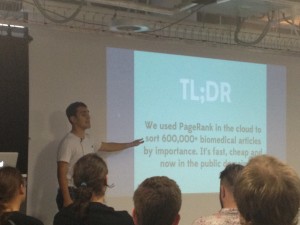Honourable hackers
11 Jul, 13 | by BMJ
BMJ hack day’s winning project – a smartphone app for patients to collect and compute home blood pressure readings – has triggered lots of social media attention and press coverage in titles such as Medical News Today, Nursing in Practice, and Mobile World Live.
The two other winners – a revision game for medical students to compete with each other using BMJ OnExamination data, and an Open Access Button that creates a “map of frustration” each time a reader hits a journal article paywall, have also generated a fair degree of attention. This BMJ article explains more.
But what of the other 10 projects? Four more idea were deservedly singled out for “honourable mentions” by BMJ chief executive Tim Brooks and his fellow judges.
James Withers, a software engineer at the company that developed the predictive typing app Swiftkey, analysed feedback submitted through Birminingham Children’s Hospital’s smartphone app. The app allows patients to submit feedback, which is then displayed on its website. The system relies on managers to process the feedback regularly and respond to it. That can take days. How can that be done more effectively? What if the sentiment in each sentence could be analysed?
James, who has a PhD in neuroinformatics, argued that sentiment analysis using the Apache Open neurolinguistic programming (NLP) library to process natural language text could be applied across the NHS to evaluate positive versus negative statements. Eighty per cent of the Birmingham feedback had at least one positive statement, he discovered.
His project slide on the Rewired State hack site, explains more: “I investigated how to use topic and sentiment analysis to tag feedback, how to trace evolving sentiment in order to flag pain points and suggestions in a message, and how to extract entities.
“With all this information then a manager can quickly target their responses and ensure the tagging is relevant. Furthermore, this information can prime the language models of a predictive messaging app (such as the Healthcare product produced by SwiftKey) in order to give a quick, accurate response to the patient.
“In the future a combination of machine learning and natural language processing techniques could reconstruct the patient journey, exploring their emotions and experiences at each touchpoint. This could happen in an automated fashion on a very large scale, and allow for very powerful analysis and transformational tools to be developed.”
The logical end point, he told judges and fellow hackers in his final “show and tell” presentation, could be to tie sentiment analysis results into NHS reports.
The second honorable mention went to MEDiCAL’s easy to use interactive medical student calendar with teaching resources using Javascipt calendar, and Google calendar. The resource aims to spare students turning up for events scheduled for 8 am, only to discover that they had been reschedued. A teacher creates an event, says who is eligible to attend, links it to relevant journal articles or BMJ learning modules, and students can then log in and book a place or join a waiting list. The tool could also include session feedback and track attendance.
MedicalNow’s offers real time notification to nurses to prevent dehydration and other complications. Hacker Elliott Hughes said the current system was paper based, and because papers get lost, giving nurses an extra prompt is helpful and helps to minimise problems. In future the resource could be integrated with BMJ Best Practice’s dataset and incorporate more data to accommodate changes in a patient’s medication etc.
Tim’s final honourable mention went to a page rank for biomedical literature resource developed by Elliot Yates (pictured above), Jairo Diaz, Leo Campbell, and Antonio Matarrese. The team parsed data from 600 000 open access articles on PubMed Central through Java and Ruby programming languages to demonstrate that papers can be ranked not merely on the number of citations, but on the quality of citations. The team concluded that a paper with 2200 citations was of higher quality than one with 5000 citations, based on the calibre of the people citing it. They demonstrated this using a colour coded tag cloud. showing Mr Red, Mr Yellow, and Mr Blue.
The team felt the tool would be useful for journals considering peer reviewers, and for authors considering which journal to submit papers to.
David Payne is editor, bmj.com, and readers’ editor.

